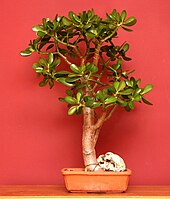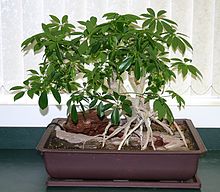Plants suitable for indoor bonsai
Tropical
The creation of bonsai is limited only by the imagination and talent of the gardener, although some species are much more suitable than others. Members of the genus Ficus are among the most versatile, while many succulents can be grown in a similar fashion. Here is an incomplete list of the most popular species.[8]
 Crassula ovata
Crassula ovata - Crassula ovata: The jade plant is a very robust and drought-resistant house plant. The miniature cultivars like the baby jade plant (C. ovata arborescens) is considered the best plant for a first bonsai. This plant will sprout on old wood. Thus, an old specimen can be pruned back to a stockier shape with thick trunk. It is kept dry in winter, placed outdoors in summer for full growth. Its roots are thin and cannot be exposed.
- Cycas revoluta: This plant is often used as an indoor bonsai. Though it does not have a traditional tree shape, it can give an image of a tropical island.
- Dracaena marginata: The dragon plant has an interesting palm-like shape. It can sprout on old wood. It does not tolerate root exposure.
- Ficus benjamina: The Weeping Fig is a popular indoor tree that lends itself to the classical, upright form. It is one of the few tropicals that are accepted as "true" bonsai. The miniature cultivars like 'Too Little' are also well suited for bonsai. It forms aerial roots and can be shaped as a banyan tree. Ficus are intolerant to branch down-pruning; one must start with a small tree and keep it small. They are sensitive to stress.
- Ficus salicaria: According to Jerry Meislik, "the most useful fig for bonsai is the willow leafed fig. The small leaf is in excellent scale for bonsai and the tree has good branch ramification, good basal rootage and excellent aerial root formation."[9]
- Portulacaria afra: The dwarf jade looks a lot like a baby jade plant and is used similarly.
 Heptapleurum arboricola
Heptapleurum arboricola - Heptapleurum arboricola: The Hawaiian umbrella tree is a popular, hardy houseplant that is ideal for irregular, banyan or roots-on-rock forms.[10] Since it can sprout on old wood, an old specimen can be pruned back to a stockier shape with thick trunk and roots. It tolerates root exposure very well, is drought-resistant and requires a moderate amount of light. Under high humidity conditions, it produces aerial roots and can therefore be shaped as a banyan tree.
- Schlumbergera: The Christmas cactus does not have a real trunk but easily lends itself to a cascade-type bonsai shape. It tolerates shade, not drought.
- Tamarindus indica The tamarind has recently become popular in bonsai culture, frequently used in Asian countries like Indonesia, Taiwan and the Philippines. In the last Japan Airlines World Bonsai competition, Mr. Budi Sulistyo of Indonesia won the second prize with an ancient tamarind bonsai.
Small succulents may be used as accent plants:
You received this message because you are subscribed to the Google Groups "1top-oldtattoo-1" group.
To unsubscribe from this group and stop receiving emails from it, send an email to 1top-oldtattoo-1+unsubscribe@googlegroups.com.
To view this discussion on the web visit https://groups.google.com/d/msgid/1top-oldtattoo-1/CAGNPKmmv%3D%2BiqPzZAcDAiu9-%2B8wguQ4_09q9b%3DArRa_8Cb4L7gg%40mail.gmail.com.
No comments:
Post a Comment